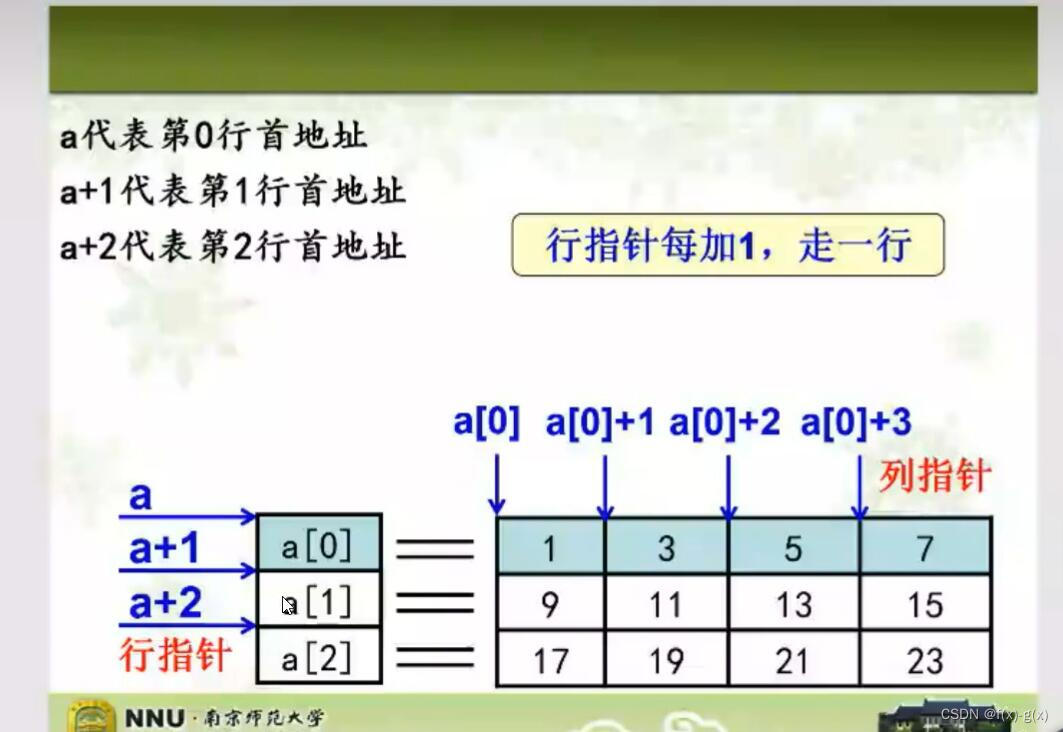-
int* p[10]和(int*) p[10]的区别
int* p[10]是一个有十个指针的数组,该指针指向整型数据;
(int*) p[10]是一个指向有十个整型数据数组的指针。指针,指向一个数组,数组里面包含10个元素看下面这段代码,就能清晰的理解了:
**(p+i)这个表示加行数,**p+i表示加列数
int main() { int b[3][4]={1,2,3,4,5,6,7,8,9,10,11,12}; int (*p)[4]; int i,j; p = &b[0]; printf("%d",**(p+1)); //for( i=0;i<3;i++) //{ // for(j=0;j<4;j++) // printf("%d ",*(*(p+i)+j)); // printf("\n"); //} system("pause"); //return 0; }- 1
- 2
- 3
- 4
- 5
- 6
- 7
- 8
- 9
- 10
- 11
- 12
- 13
- 14
- 15
- 16
输出结果:
5二维数组:

#include#include #include int main() { int a[3][4] = {{1,2,3,4},{5,6,7,8},{9,10,11,12}}; int i,j; for(int i =0;i<3;i++) { for(j=0;j<4;j++) printf("%5d",a[i][j]); printf("%5d",*(*(a+i)+j)); printf("%5d",(a[i]+j)); } system("pause"); } - 1
- 2
- 3
- 4
- 5
- 6
- 7
- 8
- 9
- 10
- 11
- 12
- 13
- 14
- 15
- 16
输出:
1 2 3 4 512186300 5 6 7 8 912186316 9 10 11 12-185084198812186332结合图片和代码来看,
a<==>&a[0] <=>a+0<=>a+i行指针(站在队伍的开头,并没有进入这个队伍)
*(a+i)<=>a[i]<=>&a[i][0]<=>指向了一个数组元素对以上指针形式进行修改:

int main() { int a[3][4]={{1,2,3,4},{5,6,7,8},{9,10,11,12}}; int i,j; int *pa; pa = a; for(i=0;i<12;i++) { printf("%5d",*(pa+i)); if((i+1)%4==0) printf("\n"); printf("\n"); } }- 1
- 2
- 3
- 4
- 5
- 6
- 7
- 8
- 9
- 10
- 11
- 12
- 13
- 14
pa=(int*)a这里要强转类型,不然会报错
#include#include #include int main() { int a[3][4]={{1,2,3,4},{5,6,7,8},{9,10,11,12}}; int i,j; int *pa; pa = (int *)a;//pa = a+ 0 for(i=0;i<3;i++) { for(j=0;j<4;j++) printf("%5d",*(pa+4*i+j));//因为在内存中二维数组是线性存储的,结合图像很好理解了 printf("\n"); } return 0; } - 1
- 2
- 3
- 4
- 5
- 6
- 7
- 8
- 9
- 10
- 11
- 12
- 13
- 14
- 15
- 16
- 17
输出:
1 2 3 4
5 6 7 8
9 10 11 12改成一维输出:
for(i=0;i<12;i++)
{
printf(“%5d”,*(pa+i));
if((i+1)%4==0)
printf(“\n”);
}
输出跟上面的是一样的。指针数组:


#include#include #include int main() { int i=1,j=2,k=3,m=4; int *pa[4]={&i,&j,&k,&m}; for(int v=0;v<4;v++) printf("%d ",pa[v]); system("pause"); } - 1
- 2
- 3
- 4
- 5
- 6
- 7
- 8
- 9
- 10
- 11
输出:d4ed9c d4ed80 d4ed84 d4ed88

指向指针的指针

通过下列的代码理解二级指针的关系:#include#include #include int main() { char *pc[] = {"beijing","nanjing","xian"}; int i; char **pe = pc; for(i=0;i<3;i++) { puts(*pe++); } system("pause"); return 0; } - 1
- 2
- 3
- 4
- 5
- 6
- 7
- 8
- 9
- 10
- 11
- 12
- 13
- 14
- 15
输出:
beijing
nanjing
xian#include#include "process.h" typedef struct person { char name[31]; int age; char address[101]; }Person; int main(void) { Person per[2] = { {"Qian",25,"west street 31"}, {"Qian",25,"west street 31"} }; Person *p1; char *p2 = per[0].name; printf("per=%u\n",per); printf("&per[0]=%u\n",&per[0]); printf("per[0].name=%u\n",per[0].name); printf("&per=%u\n",&per); system("pause"); } - 1
- 2
- 3
- 4
- 5
- 6
- 7
- 8
- 9
- 10
- 11
- 12
- 13
- 14
- 15
- 16
- 17
- 18
- 19
- 20
- 21
- 22
- 23
per[0].name出的是地址,只有*per[0].name会出Q的AsCII码,而且只有一个字母没有其他的。
f(char *s) { char *p=s; while(*p!='\0') p++; return (p-s); } int main() { printf("%d\n","ABCDEF"); system("pause"); return 0; }- 1
- 2
- 3
- 4
- 5
- 6
- 7
- 8
- 9
- 10
- 11
- 12
输出:7100232
注意:s只是一个地址没有正式进入这个字符串中,如果改成*“ABCDEF”,就会输出A的SCII码
int main() { int a[10]={6,7,2,9,1,10,5,8,4,3},*p,*s; s =a; printf("Themax:%d",*s); system("pause"); return 0; }- 1
- 2
- 3
- 4
- 5
- 6
- 7
- 8
- 9
输出:Themax:6
这个s进入了该一维数组
int main() { BitTree S; printf("请输入第一个节点的数据:"); S = CreateLink(); ShowXianXu(S); //int a = stronger("123","123456"); //printf("%d\n",a); char ch[2][5] = {"693","825"},*p[2]; int i,j,s=0; for(i=0;i<2;i++) p[i]=ch[i]; for(i=0;i<2;i++) for(j=0;p[i][j]>='0'&&p[i][j]<='9';j++) s=10*s+p[i][j]-'0'; printf("%d\n",s); system("pause"); return 0; }- 1
- 2
- 3
- 4
- 5
- 6
- 7
- 8
- 9
- 10
- 11
- 12
- 13
- 14
- 15
- 16
- 17
- 18
- 19
输出:693825
将字符’0’-’9’转换成数字。
只需将字符变量减去’0’就行了。
x=str[i]-’0’; //当字符在0和9之间, 计算其代表的数字
字符和数字在内存里都是以ASCII码形式存储的。
减去’0’,其实就是减去字符’0’的ASCII码 而字符’0’的ASCII码是30,所以减去’0’也就是减去30,然后就可以得到字符对应的数字了。
这个写法有点像在炫技,把p改成ch输出答案都是一样的 -
相关阅读:
Building VTK in Ubuntu 22.04. OpenGL missing.
BGP笔迹2
go 线程限制数量v2 --chatGPT
apache VirtualHost Alias 配置
华为交换机ssh远程登录配置命令
Redis优化之单作品数据缓存
面试经典(7/150)买卖股票的最佳时机2
SRDenseNet
微软官方操作系统(需空U盘)
1462. 课程表 IV
- 原文地址:https://blog.csdn.net/qq_43794560/article/details/127434902
